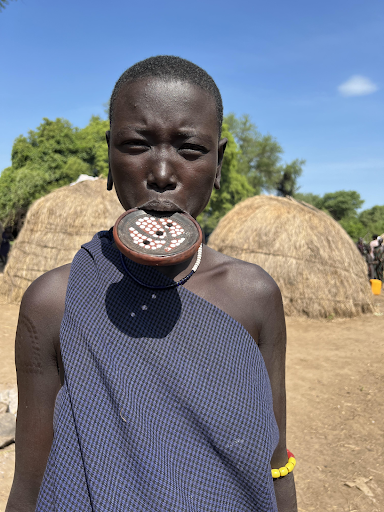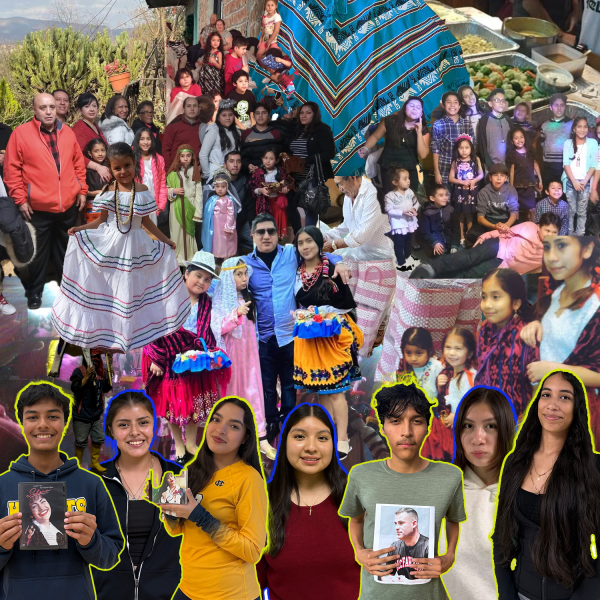CHHS senior travels to Ethiopia, logs experiences with tribes

The female members of the Mursi tribe of Ethiopia start wearing lip plates around puberty to signify their journey to womanhood.
“Good morning passengers! This is your captain speaking. I’d like to welcome everyone aboard Egyptair, Flight MS 851 flying from Cairo to Addis Ababa.” Hello, Ethiopia!
On the morning of November 1, my family and I flew into Addis Ababa, the capital of Ethiopia, for an exciting 12-day trip. Informally known as “the birthplace of humanity,” Ethiopia is a large country situated in the Horn of Africa on the East. It’s also known for being the origin of coffee, harboring the Great Rift Valley and being the oldest independent country in Africa! The remains of a human skeleton structure called Lucy, one of the oldest human skeletal systems in the world, were also discovered in Ethiopia.
As the plane took off from the runway, I considered the history of Ethiopia; my anticipation for this trip was building!
I remember flying in from Cairo and being taken aback by the harsh shift in weather. The humid air of the night was a stark contrast to the heat of Egypt. Ethiopia has a diverse climate that ranges anywhere from equatorial rainforest to deserts and valleys. Many animals like ostriches, lions, warthogs, hartebeests, monkeys and more roam the landscape freely!
Ethiopians also have multiple rich cultures, and throughout the country, you can find people actively practicing theirs; celebrations culminating in song and dance. A common food in Ethiopia is injera, a flat bread that is typically eaten with doro-wat, shiro or other stews. Injera is made from the “false banana plant” known in Amharic, the official language of Ethiopia, as enset.
Ethiopians celebrate Gena (Christmas), Timkat, and Meskel. The most popular religion is Orthodox Christianity followed by Islam. Since religion plays a large part in their society, dozens of churches and mosques can be found in each city. Socially, the people are very generous and outgoing — they also tend to have plenty of pride in their country. Ethiopian flags often cover walls and hang from rooftops. Additionally, there are over 86 tribes and languages spoken nationwide, each different from one another.
Below, I’ll go into detail about some of the most eye-catching tribes and cultures that I experienced while on this trip!
Day 7 of our trip was when my and my family’s vacation truly began! The very first tribe that we met was the Dorze. The Dorze tribe is made up of roughly 60,000 people. They live in the Gamo Highlands in southern Ethiopia and speak the Gamo language, a dialect of the Afroasiatic language.
During our visit with the Dorze, our guide gave us a tour through one of their villages. Known for their exceptional weaving skills, the Dorze people dressed us in their traditional hand-weaved clothing before we entered their village. Both men and women drape themselves in beautifully woven red (symbolizing bloodshed and war), yellow (representing hope for their future) and black (symbolizing the skin of the people) clothes. Their houses are also weaved, from bamboo, into the shape of an elephant head. This acknowledges the elephants that used to roam the area in which the Dorze live. Enset is a fruitful plant the Dorze use for food, fiber, and structure. Our stay proved itself to be magnificent. Not only were the Dorze incredible people but so was the view from our lodge. Our hotel was perched at the very top of a mountain that overlooked two incredibly large lakes, Lake Chamo and Lake Abaya. All in all, our visit with the Dorze and our stay at the Dorze lodge was extremely interesting!
On Day 9, we continued our drive south to meet the Mursi tribe. They have roughly 7,500 – 10,000 people and are divided into 18 clans. Most villages are situated in the far southwest corner of Ethiopia, just north of the Kenyan border in the valley of the River Omo.
When we visited the Mursi, we were shown the types of homes they reside in, traditional foods and some of their traditions. The basis of the Mursi diet is a type of porridge, prepared from sorghum and corn. It is mixed with milk and blood, taken directly from a wound on the neck of a cow. They rarely eat meat, usually only during festive events or a drought.
Their houses are low abodes made from sticks and cow dung with thatched roofs. The entrances are only waist-level high so that large wild animals cannot enter, and at night they block the doorway with piles of thorny acacia branches for safety.
One very interesting practice I learned about the Mursi was their lip stretching tradition. Typically, when a woman enters maturity, a plate is placed in her lip and over time it’s replaced with larger and larger plates. This practice symbolizes status and is also a standard of beauty. Earlobe stretching is also a common tradition but more typical among men. The Mursi often get a bad reputation for being aggressive people, but after meeting them, I can honestly say that they are very friendly and generous. Their culture is beautiful, and I was delighted to learn more about it.
At this point, my family and I had been driving for days on end and we were all a bit worn out. We stayed at a beautiful hotel the night before and then hit the road in the early morning of Day 10. By midday, we arrived at a village of the Hamer tribe and got to witness their unique traditions! With a population of about 60,000, these people are semi-nomadic pastoralists living in the Omo River Valley.
The Hamer tribe had one of the coolest traditions I’ve ever seen: bull jumping! This occurs when an adolescent boy (although they can be over 18) officially makes “his way into manhood.” When the boy’s father thinks he is ready, the bull jumping ceremony is put into motion by the whole village. Everyone dresses up, traditional music is played and people dance! Because this tradition doesn’t happen often, we were lucky to experience it. The bull jumping is the final part of the ceremony. The boy undresses, dozens of cows are frantically lined up and he dramatically sprints over their backs numerous times. Being able to witness such incredible traditions, and the rainbow following the rainfall during the ceremony, reminded me of what it means to be a community.
“Being at this ceremony was like being at an intimate wedding.” Margo Kennedy said. “I was transported back in time. To see these long-held traditions of this culture, I felt like I was in a different era. But it was one of the highlights of my trip.”
I can conclude this travelogue by saying I am grateful for my trip to Ethiopia. I was introduced to new foods, traditions, views and people. The opportunity to experience cultures so different from my own was very eye-opening and intriguing. Looking back, if I could do something different during my trip, I would have tried to learn some phrases in Amharic. It was easy to let our guide do the work of translating, but had I put in the effort to understand some simple sentences, I could’ve enriched my experiences by personally speaking with members of each tribe. Despite this, I still had an incredible time. I would recommend a trip to Ethiopia to any and everyone, even if you aren’t going to visit the tribes, but for the natural beauty and landscape, rich culture and incredible history!






